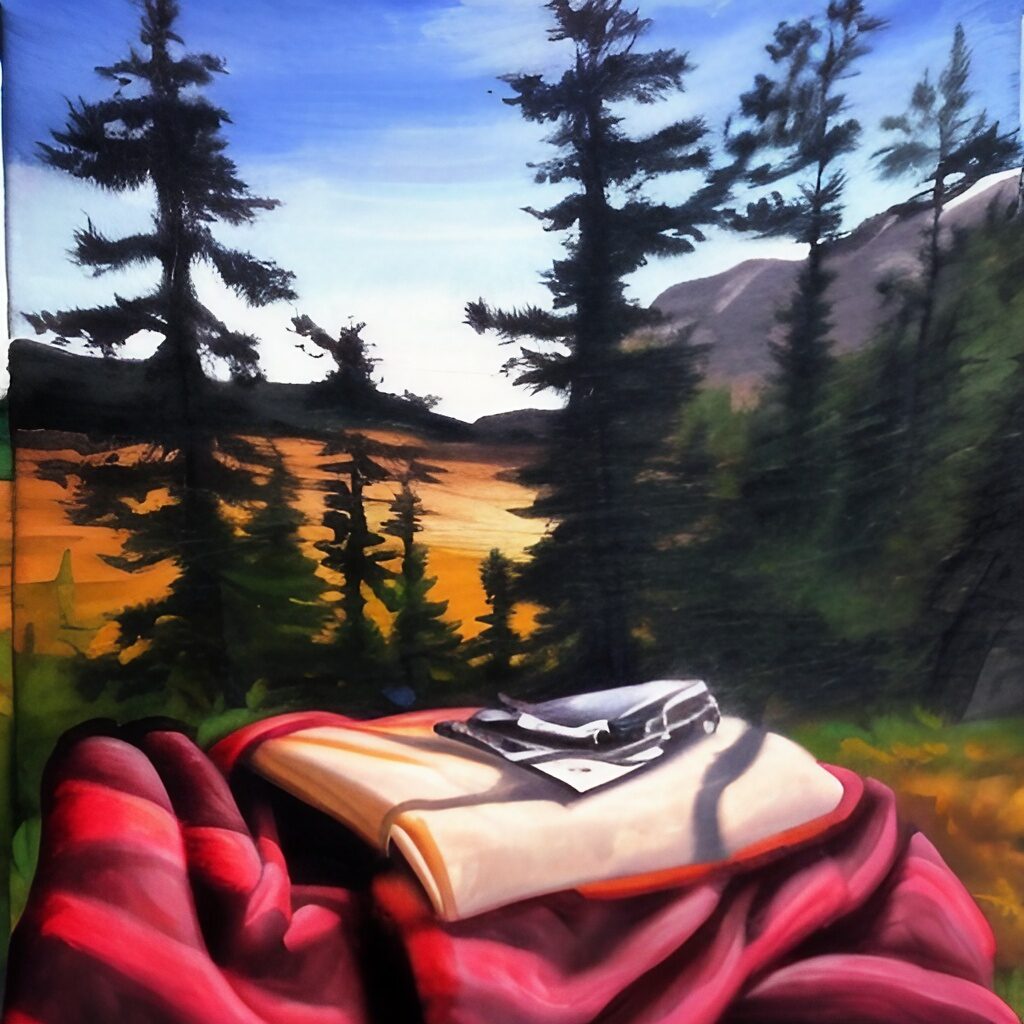
This is the ultimate head-to-head comparison of wool blankets vs sleeping bags.
Camping is a gear-heavy hobby, so it’s always convenient when you need something in your tent. Wool blankets are a common household item that will be convenient to bring—but will they keep you warm and snug while camping?
Wool blankets are a common way to stay warm in all seasons, as they’re great at keeping moisture at bay and comfortable. However, sleeping bags are warmer, lighter, and more cost-effective.
There’s a lot to cover here, so I’m calling on my experiences and research skills to provide a detailed evaluation of both items.
| Feature | Wool Blanket | Sleeping Bag |
| Weight | Heavier | Ranges from a little lighter to ultralight |
| Comfort | Emulates a bed situation; adds no comfort to sleeping pads | Adds more comfort to sleeping pads |
| Warmth | Often used for keeping cool; decent warmth | Excellent warmth |
| Versatility | Can be used in many scenarios | Depends on the bag; slightly less versatile than blankets |
| Packed Size | Bulky | Compact |
| Protection | Highly fire and water-resistant; may attract bugs | Good water and fire resistance; won’t attract bugs |
| Price | Usually more expensive | Usually more affordable |
- Overview – Wool Blankets vs Sleeping Bags
- Weight – Wool Blankets vs Sleeping Bags
- Comfort – Wool Blankets vs Sleeping Bags
- Warmth – Wool Blankets vs Sleeping Bags
- Versatility – Wool Blankets vs Sleeping Bags
- Packed Size – Wool Blankets vs Sleeping Bags
- Protection – Wool Blankets vs Sleeping Bags
- Price – Wool Blankets vs Sleeping Bags
- Do I Need a Sleeping Pad With a Wool Blanket or Sleeping Bag? – Wool Blankets vs Sleeping Bags
- How to Choose a Wool Blanket – Wool Blankets vs Sleeping Bags
- How to Choose a Sleeping Bag – Wool Blankets vs Sleeping Bags
- Conclusion: The Winner – Wool Blankets vs Sleeping Bags
- Frequently Asked Questions – Wool Blankets vs Sleeping Bags
Overview – Wool Blankets vs Sleeping Bags
There are lots of types of sleeping bags, and I’m focusing mainly on mummy bags as they offer the most warmth. Let’s compare them directly to wool blankets and see what points stand out.
Wool Blanket – Overview
Wool blankets have been used for comfort and warmth for decades. They’re typically made of sheep’s wool woven into thick yarn.
They’re natural, very cozy, and lighter in weight than thicker quilts, but they’re heavy in terms of adding them to your pack.
That said, they’re often worth the extra weight, as they’re great at keeping you warm and dry when a sleeping bag gets sodden with prolonged use.
These versatile blankets can be used during the day or at night, and they come in many different shapes and sizes to suit anyone’s needs.
Sleeping Bag – Overview
Sleeping bags are more popular nowadays, and there are many different types of them. Some of these types include:
- Mummy bags
- Rectangular bags
- Hybrid bags
- Sleeping pods
And of course, there’s always the synthetic vs down argument.
Sleeping bags are better for being lightweight and keeping you warm, although they don’t have the same cozy feeling that a wool blanket brings. They’re also not as versatile, but they’re truly the best for cold-weather camping.
Weight – Wool Blankets vs Sleeping Bags
Winner: Sleeping bags
Wool blankets are heavier than sleeping bags, so you’ll want to factor that into your choice.
Weight doesn’t always matter, but it comes into play if you have to carry your pack for any length of time. Backpackers and walk-in campers need something light. Car campers don’t need to worry about weight.
Let’s directly compare products for weight comparison purposes:
- EKTOS 100% Wool Blanket—5 pounds
- Forceatt Mummy Sleeping Bag—3.57 pounds
The wool blanket is heavier, and that weight difference will only increase if you consider a larger, thicker blanket vs an ultralight sleeping bag for backpacking.
Comfort – Wool Blankets vs Sleeping Bags
Winner: It’s a Tie
Comfort is subjective, so there’s no real winner out of these two—it’s a factor that’s high up to preference.
Sleeping bags add more cushioning underneath you, but wool blankets go on top of you, so they add no comfort to your sleeping surface.
Wool blankets are great to use with camping cots and thick sleeping pads, though; they help you feel like you’re sleeping in a real bed due to their quilt-like nature.
A lot of people prefer wool blankets for nostalgia and romanticization purposes, but I wouldn’t recommend basing your choice solely on that.
Warmth – Wool Blankets vs Sleeping Bags
Winner: Sleeping Bags
Sleeping bags are always the warmer choice due to their material and construction.
Sleeping bags are closed, so there’s no cold air around the sides or bottom. Mummy bags have hoods, too, and they’re tightly fitted to your legs to minimize airflow.
Their materials are closed and usually synthetic, but down bags are also very much closed off and not airy. They don’t allow much breathability.
Wool is breathable, so you’ll always be cooler with a wool blanket. The blanket can lift and shift as you move, too, letting cold air at your body from all angles.
People often use wool blankets to stay cool while sleeping in summer, so keep that in mind when making your choice.
Versatility – Wool Blankets vs Sleeping Bags
Winner: Wool Blankets
Wool blankets can be used as a blanket, a sun and wind shelter, a picnic blanket, something to make the floor warmer when sitting during the day, and more.
It’s much harder to do this with a sleeping bag.
Mummy bags can only be used as sleeping bags, and rectangular bags can be unzipped fully and used as blankets, but it’s more convenient to use a wool blanket. They’re already unzipped and they don’t require re-zipping before your next use.
Packed Size – Wool Blankets vs Sleeping Bags
Winner: Sleeping Bags
Wool blankets can only be folded or rolled up for transport, and they’re often thick, so they can’t compress into a small packed size. The larger the blanket, then the larger its packed size will be.
Sleeping bags can roll up very small, and they compress well.
Let’s go back to the products from earlier and compare them. The sleeping bag folds up into a 15 by 11-inch package.
The blanket is 660 by 90 inches, and let’s say you can fold it in half three times. It’s going to be 20 by 30 inches, and those dimensions won’t change much if you roll it up.
Protection – Wool Blankets vs Sleeping Bags
Winner: Wool Blankets
Wool blankets have more protective qualities than sleeping bags. Both wool blankets and sleeping bags have some fire and water resistance, but wool blankets have more.
Wool blankets wick moisture, so they feel cold rather than wet. If a sleeping bag gets wet, then it feels soggy and unpleasant, and it takes much longer to dry due to the abundance of material in it.
Wool blankets are also fire-resistant to prevent flames from spreading.
You’re safer from hazards and the elements in a wool blanket. however, you’re not safer from bed bugs.
Bed bugs lurk in natural materials such as wool blankets, but you’ll rarely have bed bugs in sleeping bags. Bed bugs can attract other insects, making wool blankets a poor choice for insect-infested areas.
Price – Wool Blankets vs Sleeping Bags
Winner: Sleeping Bags
Sleeping bags are far more affordable than wool blankets. The products I mentioned earlier have similar prices, but even so, the wool blanket was pricier.
Of course, there are incredibly cheap and very expensive versions of both products available. Cheaper versions of items often won’t be the best, so let’s directly compare two popular brands: REI for camping goods and Woolrich for wool blankets.
For REI, $100–200 is a common price point. There are a few outliers over $200, and a handful cost over $300. Even fewer cost over $400. Most campers will find one in the $100–200 range perfectly adequate for their needs.
There are some sleeping bags that are under $100, too, and they’ll keep you warm on a budget.
High-quality Woolrich blankets start at over $100, and they’re all thin and inappropriate for camping. Thicker blankets that are appropriate for camping can climb into the $600–$700 range. The most affordable blankets are throws that are only suitable for indoor use.
There are some wool blankets that are more cost-effective and designed for outdoor use, but they’re not 100% wool. Blankets that are 100% wool often last longer, and they’re more fire-resistant than wool blends. This is the kind of blanket serious campers will want.
Do I Need a Sleeping Pad With a Wool Blanket or Sleeping Bag? – Wool Blankets vs Sleeping Bags
You don’t need a sleeping pad with a sleeping bag, as you already have a well-insulated and comfortable bottom. However, it’s still recommended that you use one.
You do need a sleeping pad with a wool blanket, as otherwise, you’ll be sleeping on the cold, hard ground.
You can read more about the benefits of sleeping pads in this article, which answers the question, “do you need a sleeping pad for camping?”
Generally, you’ll always find that a sleeping pad is a good idea while you’re camping, especially when you’re forgoing a sleeping bag. Sleeping with a wool blanket and no sleeping bag will leave you cold and uncomfortable.
How to Choose a Wool Blanket – Wool Blankets vs Sleeping Bags
Choosing a wool blanket isn’t simple. You can walk into any home furnishing store and see a wool blanket, but it won’t always be great for staying warm. Many of the ones you’ll find are only good as throws or decorative blankets.
There are three factors to consider if you want to stay warm with a wool blanket on a camping trip.
Go Hypoallergenic – How to Choose a Wool Blanket
Wool can sometimes cause irritation and allergic reactions, but there are many hypoallergenic wool blankets out there for you to use if this happens to you.
Wool isn’t a common allergen, but it’s still a good idea to find a product that explicitly states that it’s hypoallergenic.
Look for a Light One – How to Choose a Wool Blanket
If you’re set on using a wool blanket for warmth, then it’s best to use one in spring or summer. Look for a blanket that’s not too thick, and one that’s lightweight works best. A lightweight blanket is not only easier to transport, but it’s also simpler to store.
You don’t need to spend a ton on those thicker, warmer blankets, as you can achieve great results with a lighter one if you use it in warmer seasons.
Merino Wool is the Best – How to Choose a Wool Blanket
If you’re going to choose a wool blanket, then make it a merino wool one. Merino wool is usually hypoallergenic, often lightweight, and it always helps regulate temperature.
Merino wool blankets wick sweat when you’re hot and insulate you when you’re cold. They help keep your body temperature comfortable regardless of the weather conditions, so it’s always a good idea to choose this kind of wool when buying any wool clothing or gear.
How to Choose a Sleeping Bag – Wool Blankets vs Sleeping Bags
Choosing a sleeping bag is a little more involved than choosing a blanket, but I’m going to clue you in on what kind is best for what situation.
Select Which Type You Want – How to Choose a Sleeping Bag
There are two decisions to make here: mummy vs rectangular and synthetic vs down.
Mummy bags are warmer and more compact, and rectangular bags offer more wriggle room while allowing more room for cold airflow. Rectangular bags are better for people who dislike being constrained, and they’re great for spring and summer use.
Cold-weather campers should always use a mummy bag when possible, and here’s a resource for even more cold-weather camping tips.
As for synthetic vs down, it’s a matter of what your priorities are.
They both keep you warm but down is more expensive. However, sleeping bags are also lighter and pack up smaller than synthetic bags. If you value affordability over compactness, choose synthetic, and vice versa.
Evaluate the Weather – How to Choose a Sleeping Bag
Know what season you’re going to camp in most before you choose your bag.
Are you exclusively a summer camper? A rectangular bag marked for warm weather camping is a good choice.
Will you be camping more in cold weather? Then you’re going to need a warmer bag, like a mummy bag, and make sure you choose one with a decent temperature rating. I recommend a 20° bag as they work well in cold and hot weather alike.
Ensure It’s Convenient – How to Choose a Sleeping Bag
Make sure your sleeping bag is light and compact enough for you if you’re a backpacker or walk-in camper. Car campers can choose bags of any size and weight, as heavier bags won’t be inconvenient.
Finding a bag that works for you is vital, as you’ll feel more comfortable with a bag that isn’t a burden.

Conclusion: The Winner – Wool Blankets vs Sleeping Bags
Sleeping bags are clearly the winner in most situations, but wool blankets can be good for warm-weather camping. You could also pair a blanket with a sleeping bag if you’d like.
Preference should always factor in, too, but keep the benefits and disadvantages of both pieces of gear in mind. I recommend sleeping bags for almost all situations, but there’s nothing wrong with choosing a wool blanket if it works better for you.
Frequently Asked Questions – Wool Blankets vs Sleeping Bags
What are the Benefits of Using a Sleeping Bag Over a Wool Blanket? – FAQs
For camping and outdoor activities, there are several advantages to using a sleeping bag rather than a wool blanket.
To begin, sleeping bags are specifically designed for camping and outdoor use, with features that make them more versatile in a variety of weather conditions. Many sleeping bags have temperature ratings that can assist you in determining how warm they will keep you on various nights. This is especially important in colder weather, when adequate insulation is essential for remaining warm and comfortable.
Furthermore, sleeping bags frequently include hoods or drawstrings that can be adjusted to fit snugly around your head or face, providing additional warmth and protection from the elements. Some sleeping bags also include draft collars, which are insulated tubes around the neck that keep cold air out.
Another advantage of sleeping bags is their portability and ease of use. Sleeping bags can be rolled up and easily packed into a backpack or other gear without taking up much room. They are also relatively simple to set up and enter, making them ideal for short-term or overnight stays.
Finally, while wool blankets are cozy and comfortable, they may not provide adequate insulation in cold weather. Sleeping bags are designed to effectively trap body heat, keeping you warm even when temperatures fall below freezing.
In conclusion, while wool blankets can be useful in some camping situations, there are several advantages to using a sleeping bag instead. Sleeping bags’ specialized design makes them more versatile in a variety of weather conditions, easier to pack and use on the go, and better at trapping body heat for warmth during cold nights.
Are There Any Environmental Benefits to Using a Wool Blanket Instead of a Synthetic Sleeping Bag? – FAQs
Yes, using a wool blanket instead of a synthetic sleeping bag has environmental benefits.
To begin with, wool is a natural and renewable resource that has been used in clothing and textiles for centuries. Wool blankets are made from sheep fleece, which can be shorn annually without harming the animal. Synthetic sleeping bags, on the other hand, are frequently made from petroleum-based materials and do not biodegrade easily, contributing to plastic pollution.
Furthermore, the production of wool blankets typically uses fewer chemicals and energy than the production of synthetic sleeping bags. Synthetic materials require a significant amount of energy to manufacture and release harmful chemicals into the environment. Wool production is generally regarded as more environmentally friendly because it requires less energy and fewer chemicals.
Furthermore, wool blankets last longer than synthetic sleeping bags. Wool blankets can last for decades or even generations if properly cared for, reducing the need for frequent replacements and, as a result, reducing waste.
Finally, using natural materials such as wool benefits local farmers and small businesses that rely on sustainable farming practices. This promotes biodiversity in agricultural areas while also benefiting rural communities.
Overall, using a wool blanket instead of a synthetic sleeping bag can have several environmental benefits, including reduced pollution, lower energy consumption during production, a longer product lifespan, resulting in less waste generation, and support for sustainable agriculture practices.
How Do You Clean and Care for a Wool Blanket Compared to a Sleeping Bag? – FAQs
Cleaning and caring for a wool blanket is not the same as cleaning and caring for a sleeping bag.
The following are some cleaning and care tips for each.
Cleaning and Caring for a Wool Blanket:
- For minor stains or spills, a damp cloth and mild soap are usually sufficient.
- If you need to wash the entire blanket, use cold water and a gentle wool detergent. Hot water and harsh detergents should be avoided because they can cause shrinking, felting, and fiber damage.
- After washing, gently squeeze out excess water without wringing or twisting the blanket.
- Lay it flat to dry away from direct sunlight or heat sources. Hanging it up may cause stretching or distortion of its shape.
Caring for a Sleeping Bag:
- When washing your sleeping bag, always follow the manufacturer’s instructions because different materials require different care methods.
- In general, sleeping bags should be washed in cool or warm water with a mild detergent in a front-loading washer (top-loading washers with agitators can damage the insulation).
- Rinse thoroughly 2-3 times to remove all soap residue.
- Squeeze out excess water gently without wringing or twisting the sleeping bag.
- Before storing it, hang it up or lay it flat to completely dry.
In conclusion, wool blankets require less frequent washing than synthetic sleeping bags, but spot cleaning is advised. When washing wool blankets, use cold water and gentle detergent to avoid shrinkage. Synthetic sleeping bags should be washed more frequently than wool blankets, but always follow the manufacturer’s instructions and use cool/warm water with a mild detergent.














